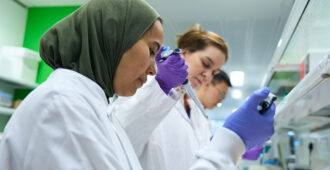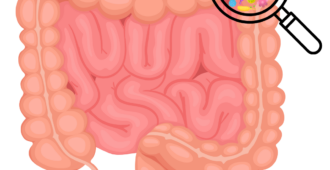Proteins are the building blocks of our cells and have a variety of important roles within our bodies. The instructions for how to build our proteins sit within our DNA, our genetic code in the control centre of our cells (the nucleus). There are many steps to go through from reading that ‘raw’ instruction to ending up with a fully functioning protein.
However, the amount of information held within our genetic code is so huge that only small segments of it are read and transferred to the factory floor, as and when they are needed. These copies, known as messenger RNA, are small enough to be transported to the ‘factory floor’ of the cell to large machine-like entities called ribosomes where the copy is read, and used to create the resulting protein.
When I was doing my A levels and later at University (yes, that long ago!), we were taught that only 1% of the genetic code ever made it to the factory floor. This held true until a couple of years ago. However, as explained by Professor Bob Brown in his presentation at the ‘RNA and protein processing’ session this afternoon, such is the change in our knowledge in that area, we now know that 95% of our genetic code makes it through to the first step of making proteins.
This was a key piece of context in trying to understand the role that TDP43 plays in functioning cells – never mind specifically in motor neurones or in cases of the presence of damaged TDP43 in MND!
Professor Brown, University of Massachusetts Medical School, Boston, USA went on to give an enlightening review of what has been uncovered about this fascinating protein (TDP43) so far. Once the protein of TDP43 has been correctly made, its function is to go back and ensure that other proteins are correctly made too – the so called ‘reading helpers’ of the cells, or ‘editors of instructions’. Another new fact to me from this talk was that TDP43 is involved in editing or reading up to ONE THIRD of all proteins within the cell. That’s a city fat cat type of job! So how is it all related to it’s function in MND?
Some elegant experiments have shown that TDP43 regulates how many copies of it’s own protein are made. However, the regulation takes place in the control centre of the cell (see the top of this blog). If TDP43 gets stuck or waylaid on the factory floor, it can’t get back to press the stop button in time. So it’s thought that more and more protein is made, accumulating on the factory floor until that accumulation can be seen as the protein deposits so characteristic of what you see of motor neurones affected by MND down the microscope.
Part of the editing work that TDP43 does so well is known as ‘splicing’. In true ‘Blue Peter’ style, here is a description of that process that Kelly prepared before I flew out to Sydney:
Alternative protein
One gene can hold the instructions for a number of different versions or variants of a protein. These variants are created when different parts of the gene are used in alternative combinations. This is a normal process and it’s called ‘alternative splicing’. This complicates matters in terms of genetic research, as even though we have approximately 20,000 genes, we could potentially have a much higher number of functional proteins because of alternative spliced variants.
How does alternative splicing work?
The picture (below) depicts a simple version of how a gene can be alternatively spliced, given three ‘parts’. The example demonstrates that the first version of the protein is made up of parts 1, 2 and 3, whereas version two is made up of only parts 1 and 3. These resulting proteins would go on to function in our bodies in potentially different ways. It is therefore possible for a number of different proteins to be created given one set of original instructions in the genetic code.
Read our official day one symposium press release on our website.







Comments are closed.